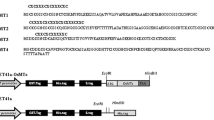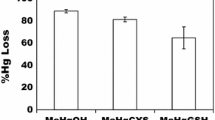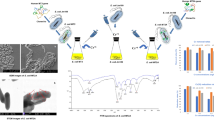Abstract
Recombinant tilapia (Oreochromis mossambicus) fish metallothionein (MT) was used as a surface biosorbent for mercury removal in Escherichia coli. Fish MT conferred better resistance than did mouse or human MT. When tilapia MT (tMT) was fused with an outer-membrane protein, outer membrane protein C (OmpC), the membrane-targeted fusion protein, OmpC–tMT, gave enhanced resistance compared with cytoplasmic tMT expressed in the same host cell. The cytoplasmically expressed tMT showed high mercury adsorption (4.3 ± 0.4 mg/g cell dry weight). The cell surface that expressed E. coli showed about 25% higher adsorption ability (5.6 ± 0.4 mg/g) than the cells expressing cytoplasmic MT, attaining almost twice the level of adsorption of the control plasmid (3.0 ± 0.4 mg/g). As MTs are also known for their ability to scavenge hydroxyl-free radicals, it was also shown that tMT exhibited better radical-scavenging activities than glutathione. These results suggest that fish MT has potential for the development of a bioremediation system for mercury removal that protects the harboring E. coli host by free-radical scavenging.




Similar content being viewed by others
Reference
Allen P (1994) Mercury accumulation profiles and their modification by interaction with cadmium and lead in the soft tissues of the cichlid Oreochromis aureus during chronic exposure. Bull Environ Contam Toxicol 53:684–692
Bae W, Mehra RK, Mulchandani A, Chen W (2001) Genetic engineering of Escherichia coli for enhanced uptake and bioaccumulation of mercury. Appl Environ Microbiol 67:5335–5338
Bardwell JC (1994) Building bridges: disulphide bond formation in the cell. Mol Microbiol 14:199–205
Belliveau BH, Trevors JT (1989) Mercury resistance and detoxification in bacteria. Appl Organomet Chem 3:283–294
Brand-Williams W, Cuvelier ME, Berset C (1995) Use of a free radical method to evaluate antioxidant activity. Food Sci Technol Res 28:25–30
Capasso C, Abugo O, Tanfani F, Scire A, Carginale V, Scudiero R, Parisi E, D'Auria S (2002) Stability and conformational dynamics of metallothioneins from the antarctic fish Notothenia coriiceps and mouse. Proteins 46:259–267
Capasso C, Carginale V, Crescenzi O, Di Maro D, Parisi E, Spadaccini R, Temussi PA (2003) Solution structure of MT_nc, a novel metallothionein from the Antarctic fish Notothenia coriiceps. Structure 11:435–443
Chan KM (1995) Metallothionein: Potential biomarker for monitoring heavy metal pollution in fish around Hong Kong. Mar Pollut Bull 31:411–415
Chen S, Wilson DB (1997a) Construction and characterization of Escherichia coli genetically engineered for bioremediation of Hg(2+)-contaminated environments. Appl Environ Microbiol 63:2442–2445
Chen S, Wilson DB (1997b) Genetic engineering of bacteria and their potential for Hg2+ bioremediation. Biodegradation 8:97–103
Coyle P, Philcox JC, Carey LC, Rofe AM (2002) Metallothionein: the multipurpose protein. Cell Mol Life Sci 59:627–647
Gadd GM, White C (1993) Microbial treatment of metal pollution—a working biotechnology? Trends Biotechnol 11:353–359
Harada M (1995) Minamata disease: methylmercury poisoning in Japan caused by environmental pollution. Crit Rev Toxicol 25:1–24
Jeanteur D, Lakey JH, Pattus F (1991) The bacterial porin superfamily: sequence alignment and structure prediction. Mol Microbiol 5:2153–2164
Jones DP (2008) Radical-free biology of oxidative stress. Am J Physiol Cell Physiol 295:C849–C868
Kao WC, Chiu YP, Chang CC, Chang JS (2006) Localization effect on the metal biosorption capability of recombinant mammalian and fish metallothioneins in Escherichia coli. Biotechnol Prog 22:1256–1264
Kotrba P, Pospisil P, de Lorenzo V, Ruml T (1999) Enhanced metallosorption of Escherichia coli cells due to surface display of beta- and alpha-domains of mammalian metallothionein as a fusion to LamB protein. J Recept Signal Transduct Res 19:703–715
Mejare M, Bulow L (2001) Metal-binding proteins and peptides in bioremediation and phytoremediation of heavy metals. Trends Biotechnol 19:67–73
Park JD, Liu Y, Klaassen CD (2001) Protective effect of metallothionein against the toxicity of cadmium and other metals. Toxicology 163:93–100
Re R, Pellegrini N, Proteggente A, Pannala A, Yang M, Rice-Evans C (1999) Antioxidant activity applying an improved ABTS radical cation decolorization assay. Free Radic Biol Med 26:1231–1237
Saleem M, Brim H, Hussain S, Arshad M, Leigh MB, Zia ul H (2008) Perspectives on microbial cell surface display in bioremediation. Biotechnol Adv 26:151–161
Sato M, Kondoh M (2002) Recent studies on metallothionein: protection against toxicity of heavy metals and oxygen free radicals. Tohoku J Exp Med 196:9–22
Scudiero R, Temussi PA, Parisi E (2005) Fish and mammalian metallothioneins: a comparative study. Gene 345:21–26
Silver S, le Phung T (2005) A bacterial view of the periodic table: genes and proteins for toxic inorganic ions. J Ind Microbiol Biotech 32:587–605
Sousa C, Kotrba P, Ruml T, Cebolla A, De Lorenzo V (1998) Metalloadsorption by Escherichia coli cells displaying yeast and mammalian metallothioneins anchored to the outer membrane protein LamB. J Bacteriol 180:2280–2284
Ueda M, Tanaka A (2000) Genetic immobilization of proteins on the yeast cell surface. Biotechnol Adv 18:121–140
Vallee BL (1995) The function of metallothionein. Neurochem Int 27:23–33
Valls M, de Lorenzo V (2002) Exploiting the genetic and biochemical capacities of bacteria for the remediation of heavy metal pollution. FEMS Microbiol Rev 26:327–338
Valls M, Gonzalez-Duarte R, Atrian S, De Lorenzo V (1998) Bioaccumulation of heavy metals with protein fusions of metallothionein to bacterial OMPs. Biochimie 80:855–856
Volesky B, Holan ZR (1995) Biosorption of heavy metals. Biotechnol Prog 11:235–250
Wong CK, Yeung HY, Cheung RY, Yung KK, Wong MH (2000) Ecotoxicological assessment of persistent organic and heavy metal contamination in Hong Kong coastal sediment. Arch Environ Contam Toxicol 38:486–493
Wu SM, Weng CF, Hwang JC, Huang CJ, Hwang PP (2000) Metallothionein induction in early larval stages of tilapia (Oreochromis mossambicus). Physiol Biochem Zool 73:531–537
Xu Z, Lee SY (1999) Display of polyhistidine peptides on the Escherichia coli cell surface by using outer membrane protein C as an anchoring motif. Appl Environ Microbiol 65:5142–5147
Acknowledgements
We thank Professor Jo-Shu Chang (National Cheng Kung University, Taiwan) for his kind gift of the pMAL-p2X-MT1A and pMBP-TEV-MT1 plasmids containing human MT1A and mouse MT1 cDNA. We also thank Prof. Su-Mei Wu (National Chia Yi University, Taiwan) for antibody of the rabbit anti-tMT IgG. This work was supported by the grants (NSC 96-3114-P-001-004-Y and NSC 97-3114-P-001-001) from the National Science Council, Taiwan, People’s Republic of China.
Author information
Authors and Affiliations
Corresponding author
Rights and permissions
About this article
Cite this article
Lin, KH., Chien, MF., Hsieh, JL. et al. Mercury resistance and accumulation in Escherichia coli with cell surface expression of fish metallothionein. Appl Microbiol Biotechnol 87, 561–569 (2010). https://doi.org/10.1007/s00253-010-2466-x
Received:
Revised:
Accepted:
Published:
Issue Date:
DOI: https://doi.org/10.1007/s00253-010-2466-x




